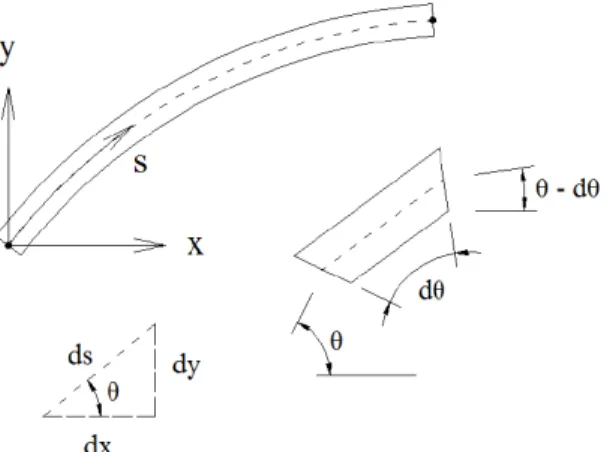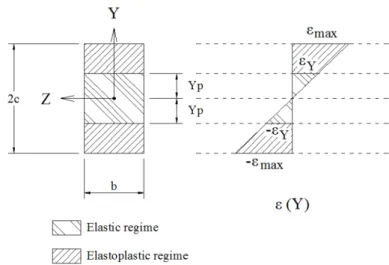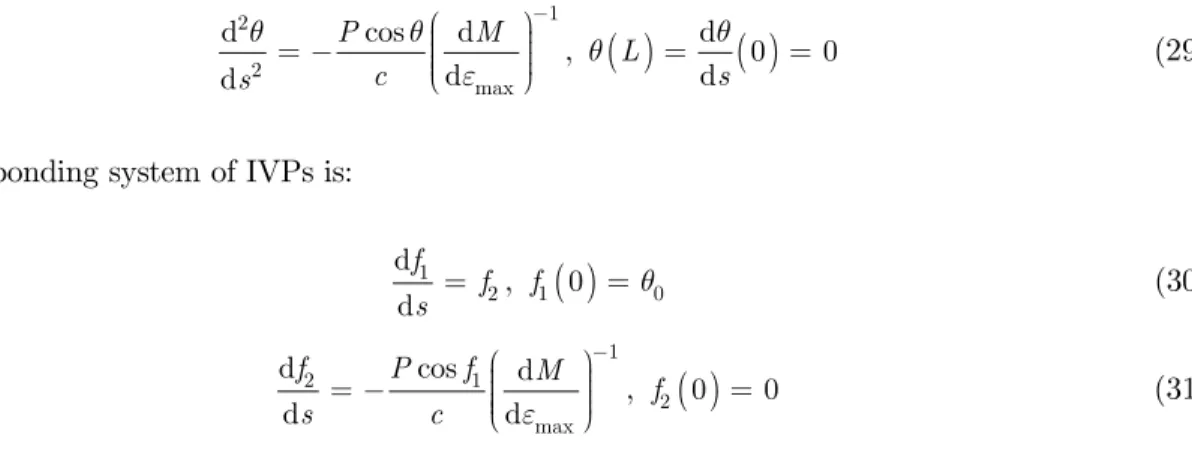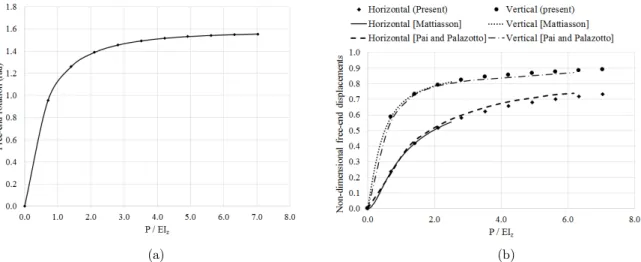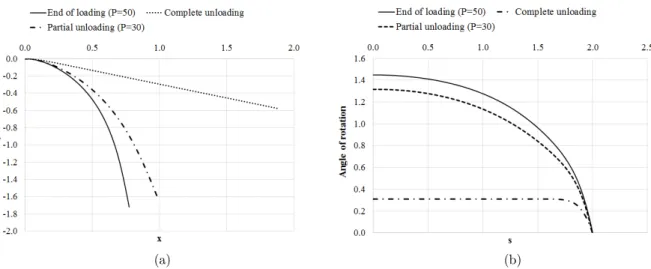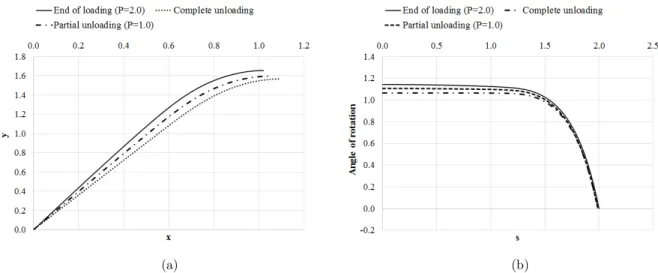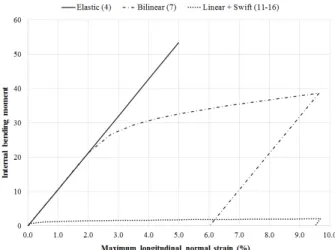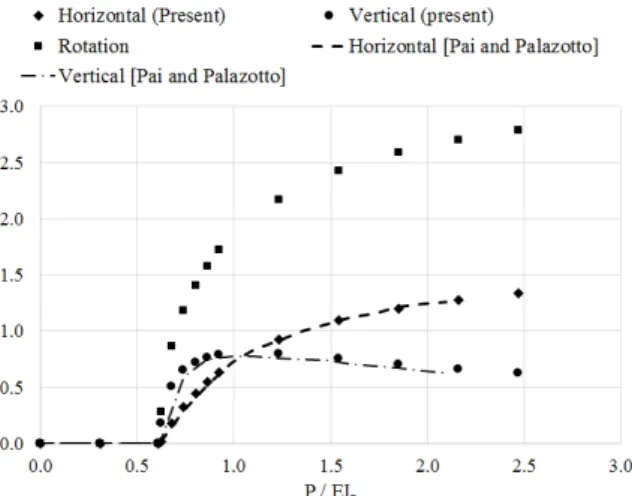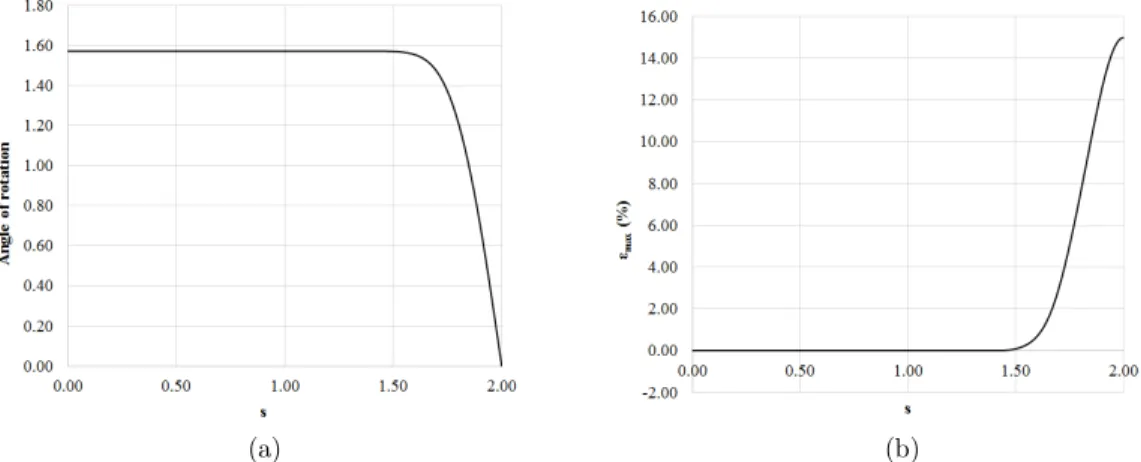Abstract
The objective of the present study is to develop a numerical formula-tion to predict the behavior of highly deformable elastoplastic thin beams. Following the Euler-Bernoulli bending, the axial and shear effects are neglected, and the nonlinear second-order differential equation regarding the angle of rotation is defined based on the spe-cific moment-curvature relationship. Although the formulation can be used for general materials, three constitutive models are employed: linear-elastic, bilinear elastoplastic, and linear-elastic with Swift isotropic hardening. The resultant boundary value problem is solved by means of the fourth-order Runge-Kutta integration procedure and the one-parameter nonlinear shooting method. The performance of the present formulation is investigated via three numerical problems involving finite bending of slender beams composed of elastoplastic materials. For these problems, numerical solutions regarding rota-tions, displacements and strains for the loading, unloading and re-loading phases are provided. Finally, it is shown that the present methodology can also be used to determine the post-buckling behav-ior of elastoplastic thin beams.
Keywords
Finite bending deformations; thin beams; elastoplastic material; post-buckling behavior; fourth-order Runge-Kutta integration; nonlinear shooting method.
Numerical analysis of highly deformable elastoplastic beams
1 INTRODUCTION
Bending of highly deformable materials is a very interesting topic. In this context, several engineer-ing applications can be cited: transmission cables, suspension sprengineer-ings, aerospace vehicle wengineer-ings, rotor blades, solar collectors, dish antennas and space stations. In general, these structures are flexible, i.e., may present large deflections when loaded. To describe the equilibrium of forces in finite deflec-tions, the geometrically nonlinear analysis is imperative. To circumvent the resultant complexity, numerical methods are usually employed.
João Paulo Pascon
Materials Engineering Department, Lo-rena School of Engineering, University of São Paulo
Polo Urbo-Industrial Gleba AI-6, PO box 116, Zip code 12600-970
Lorena, São Paulo, Brazil
Corresponding author: jppascon@usp.br
http://dx.doi.org/10.1590/1679-78251781
For slender (or thin) beams, a reasonable approach is the Euler-Bernoulli hypothesis: plane cross sections remain plane and orthogonal to the deformed axis. Another condition usually imposed is the inextensibility of the beam axis. For plane beams (or two-dimensional bending), the warping is not considered. These three assumptions can be extended to finite deformations. Based on these hypotheses, the axial, torsion and shear effects are neglected and, thus, the bending moment is the dominant internal action. The Euler-Bernoulli bending for finite deflections has been extensively used in the scientific literature, since the work of Bisshopp and Drucker (1945), which have defined the differential equation to be solved involving the exact curvature for large displacements, since the assumptions from elementary beam theory are no longer valid. Based on this differential equa-tion, various works dealing with finite Euler-Bernoulli bending have been performed (see, among many others, Jenkins et al. (1966); Holden (1972); Mattiasson (1981); Lee (2002); Chen (2010); Tari (2013)).
Regarding the material behavior, the deformations (or strains) may be elastic (reversible) or plastic (permanent). Large elastic strains are common in the context of elastomers, and large plastic deformations occur, for instance, in sheet-metal forming processes. Neglecting the shear effects, a uniaxial stress-strain relationship can be used. Even in the finite displacement analysis, the Hooke’s law can be used if the elastic strain level is small. For moderate elastic strains, a usual constitutive law is the Ludwick material model (see, for example, Lee (2002); Lewis and Monasa (1981); Monasa and Lewis (1983); Carrillo (2009)). This model has been firstly applied to the finite Euler-Bernoulli bending in the work of Lewis and Monasa (1981). In the elastoplastic regime, there are many uniax-ial models that can be used for beams (see, for instance, Hutchinson (1972); Chan et al. (1991); Cimetière and Léger (1996); Durban and Zuckerman (1999)): bilinear, multi-linear, Ramberg-Osgood, linear elastic with hardening etc. An important and very suitable model for sheet-metal forming processes is the Swift isotropic hardening law (Swift, 1947).
In solid mechanics, the bending moment is connected to the normal longitudinal stress, and the bending curvature is associated with the normal longitudinal strain. Combining these relations with the uniaxial material model, a moment-curvature relationship can be defined to analyze plane beams, for example. Obviously, this relationship is modified when the material exceeds the elastic limit and reaches the elastoplastic domain. In the work of Lewis et al. (1987), for instance, a mo-ment-curvature relationship for partially yielded rectangular cross-section is employed.
In the context of finite (or nonlinear) bending, the usual procedure is to set the nonlinear sec-ond-order differential equation regarding the angle of rotation defined as a function of the curviline-ar coordinate. In order to solve this equation, the two most common numerical techniques curviline-are: the use of elliptic integrals (see, for example, the works of Bisshopp and Drucker (1945); Jenkins et al. (1966); Mattiasson (1981); Sinclair (1979)); and the use of numerical integration along the curvilin-ear coordinate (see, for instance, Holden (1972); Lewis et al. (1987); Rao and Rao (1989)). In order to avoid the use of elliptic integrals, which are quite complicated, the second strategy has been adopted in this paper. Following the works of Holden (1972), Lee (2002), Lewis and Monasa (1981), Monasa and Lewis (1983) and Rao and Rao (1989), the differential second-order equation is ex-pressed as a system of two first-order equations, whose numerical solution is found via the fourth-order Runge-Kutta scheme and the nonlinear one-parameter shooting method. As the angle of rota-tion is defined, the plane Cartesian coordinates can be found, for example, by means of the trape-zoidal integration rule.
A specific and very important related problem is the post-buckling behavior of elastoplastic thin beams. In this context, several works can be cited as, for example, Hutchinson (1972), Cimetière and Léger (1996), Kounadis and Mallis (1987), Léger and Potier-Ferry (1993) and Grognec and Le van (2011). However, very few papers deal with the unloading and reloading phases, which is a topic that can be used, for instance, in the analyses of truss-like structures composed of elastoplastic materials. Moreover, in most of the related papers, the perfectly elastoplastic, bilinear and Ram-berg-Osgood elastoplastic models are employed. No Swift isotropic hardening law together with post-buckling behavior has been found along the bibliographic research performed.
The objective of this study is to develop a numerical formulation to predict the behavior of high-ly deformable thin beams composed of elastoplastic materials, including bilinear and Swift isotropic hardening elastoplastic laws. As said before, this formulation can be implemented in a computer code developed for nonlinear analysis of lattice structures, especially for compressed elastoplastic members. Although the present large-deformation analysis can be performed in a general way by means of the Finite Element Method (FEM), the intention here is to show an alternative simple technique to obtain some numerical solutions for elastoplastic thin beams.
Besides the Introduction, this paper is organized in four sections. The formulation regarding the nonlinear bending is described in section 2. The numerical procedure to solve the nonlinear second-order differential equation is explained in section 3. The validating numerical results, as well as their discussion, are provided in the fourth section. Finally, the main conclusions are given in section 5.
2 BENDING PROBLEM
In this paper, the effects of shearing, axial deformation and warping are neglected, and the exten-sion of the Euler-Bernoulli hypothesis to finite deflections and rotations is used:
1 d ds
(1)
where 1 is the bending curvature; is the angle of rotation; and s is the curvilinear coordinate
(see Figure 1). Adopting the inextensibility condition of the beam axis, the curvilinear coordinate s
varies from 0 to L, where L is initial length of the beam. Therefore, considering a rectangular cross
section with width b and height 2c, the longitudinal normal strain () is null at the centroid and
varies along the height, from max at the lower edge to max at the upper edge. According to Fig-ure 1, if the upper edge is elongated, the value of max is positive and the angle decreases. Thus, one can associate the curvature (1) with the maximum value of the strain as follows:
max
d
ds c
(2)
From equation (2), to associate the internal bending moment (M ) with the curvature (d d s), one
needs to define the constitutive law (or the stress-strain relation). Three cases are analyzed here: fully linear-elastic cross section; partially yielded cross section with bilinear elastoplastic material; and partially yielded cross section with Swift isotropic hardening model. For the three cases, the
Figure 1: Coordinates and angle of rotation at the current (deformed) configuration. The symbols x and y denote the rectangular coordinates.
moment M depends on the maximum strain (max), which is related to the curvature via equation (2). So, in order to obtain the moment-curvature relationship, one needs to determine the derivative of M regarding s:
1
2 2
max
2 2
max max max
d
d d d d d 1 d d
d d d d d d d d
M M M M M
c
s s s s c s
(3)
where M
max
is the specific function that associates the internal bending moment with themax-imum normal strain.
For the first case, the uniaxial Hooke’s law is employed and, thus, a well-known relation is ob-tained (see equation (2)):
max 2 max 22
d 1 d
d d d
d d
z
z
A A A
M
M Y A E Y A E Y A EI
c c s EI s
(4)where is the longitudinal normal stress; Y is the distance along the height from the centroid (see
Figure 1); E is the Young modulus; and Iz is the moment of inertia regarding the z axis, which is
normal to the bending plane.
For the second and third cases, as the material exceeds the elastic limit, a central portion of the cross remains in elastic domain, and the extreme lower and upper portions reach the elastoplastic regime (see Figure 2). Considering the bilinear elastoplastic material, the stress-strain relationship is:
E
, for Y or Y Yp (5)
Y Ep Y
, for Y or Y Yp (6)
where Y, Y and Ep are, respectively, the yield strain, the yield stress and the plastic modulus,
obtained from the uniaxial tension test. Considering (5) and (6), it is possible to show that the function is modified to:
Figure 2: Partially yielded rectangular cross section.
2 2 2
max max
2 2
3 3 3
p Y p Y
p Y Y Y
E E E
M bc E E E
(7)
Combining this expression with the result in (3):
1 2 2 3 max 2 2 2 d d 2
d 3 3 3
d
p Y p Y
Y Y
E E E
M bc s s (8)
Finally, for the Swift isotropic hardening model, it is assumed that the elastic strains are small compared with the plastic strains and, thus, all the strain is plastic in the elastoplastic regime:
E
, for Y or Y Yp (9)
0
n
K
, for Y or Y Yp (10)
where K, 0 and n are the Swift coefficients. As in expression (4), the integration of the bending
moment due to the stresses (9) and (10) leads to:
1
21 0 max 3 0 max
1 2 4
2 2 2 2
max
max max max max
n n
b b
a b b
M
(11)
3
1 z Y
a EI
c
(12)
2 1 2 1 Kbc b n
(13)
2 1 2 0 2 1 n Y Y Kbc bn
(14)
2 3 2 1 2 Kbc b n n (15)
2 2 4 0 2 1 2 n Y Kbc bn n
(16)
Therefore, the derivative that appears in (3) is:
2 3
1 2 4 3 0 max max
max
1 1 2 1
3 0 max 1 0 max max 1 0 max max
d
2 d
2 1
n
n n n
M
a b b b
b n b b n
(17)
3 NUMERICAL PROCEDURE
For a beam with prescribed boundary conditions (loading and rotations), as showed in the last sec-tion, one needs to solve a nonlinear second-order differential equation regarding the function
s(see the result of expression (3)). In general, a beam has a prescribed value at each one of the two ends: a rotation or a bending moment. So, the differential equation together with the two prescribed values is classified as a two-point boundary value problem. The procedure adopted here consists in dividing this equation in a system of two initial value problems (IVPs). To do this, two auxiliary functions are used: f s1
and f2
s d d s. With these functions, we write the followingsys-tem of two IVPs:
1 2 d d f f
s , f1
0 0 (18)1 2
max
d 1 d d
d d d
f M M
s c s
, 2
0 d 0 d f s
(19)
where 0 and
0
d d s are the initial values at the end of the beam in which the origin of s is
placed. Even in the case of nonlinear systems, if these values are known, the solution of the system can be found via a numerical procedure. In this study, the beam is split into a finite number of segments and the fourth-order Runge-Kutta method is employed to solve the system of equations (18) and (19). Once determined the values of and d d s at the extreme points of each segment,
the rectangular coordinates x and y can be obtained via numerical integration. From Figure 1,
these coordinates are determined using the trapezoidal rule:
cos d cos
cos
2
s s
s
s
x x s s x s s
(20)
sin d sin
sin
2
s s
s
s
y y s s y s s
(21)where the symbol Δ denotes the finite variation of some quantity along the segment. As the equi-librium is described at the final (deformed) configuration, x and y are the final rectangular
coordi-nates.
The problem in applying the Runge-Kutta procedure to the system of equations (18) and (19) is that the initial values 0 and
0
d d s are not simultaneously known at one of the two ends of the
beam. For example, in a cantilever beam under a free-end shear force, the bending moment at the
free end is zero and, hence,
0
d d s 0. However, the angle of rotation at this point is not pre-scribed and, thus, the integration of equation (18) from the free end to the clamped edge depends on the unknown value 0. To deal with this inconvenient, the shooting method is used. In the case of the above-mentioned cantilever, the sequence of IVPs (18) and (19) are solved in such a way that the solution converges to 0 at the clamped edge. Therefore, the objective is to find the angle of rotation at the free end (0) that corresponds to the null rotation at the clamped edge. As there is only one parameter (0) and the differential equation is nonlinear, the applied method is the one-parameter nonlinear shooting method. Alternatively, if the integration is performed from the
clamped edge to the free end, the objective is to determine the initial value
0
d d s that
corre-sponds to 0 at the clamped edge and d d s 0 at the free end.
During the loading phase, the solution clearly depends on the material regime. The differential equation is modified if the material exceeds the elastic limit (see expressions (3), (4), (8) and (17)). If the beam reaches the elastoplastic regime, the first task is to determine the curvilinear coordinate (s) that corresponds to the threshold between the elastic and elastoplastic parts of the beam. This
determination is done based on the yield stress limit (Y). In the case of a bending moment in-creasing along the curvilinear coordinate, if the maximum stress at s sn is lower than Y, and
the maximum stress at s sn 1 is higher than Y, the size of interval s s sn is updated
until the integration from sn provides a maximum stress sufficiently close to Y . As this threshold
is obtained, the integration considering the elastoplastic regime is performed from s s to s L.
For the unloading phase, it is assumed that the material response is purely elastic and, thus, equation (4) together with the solution obtained from the end of the loading can be used. To guar-antee that the response is purely elastic for the bilinear elastoplastic material, the hardening is as-sumed to be isotropic and, thus, the stress limit is not changed as occurs in kinematic hardening. Assuming that the applied forces are completely removed, the internal bending moment returns to zero along the entire beam. If M is the function that describes the internal moment along the beam
length at the last step of the loading phase, then:
max
max
0 d z
z A
Mc
M M M Y A EI M
c EI
(22)Of course, along the part of the beam that remained in elastic regime, the strains return to zero, and the permanent (or residual) strain remains even after the complete unloading for the elasto-plastic part.
Along the reloading phase, if the material remains in elastic regime, the equation (4) can also be employed. Otherwise, one of the elastoplastic equations (8) or (17) must be solved. However, even in the case of a complete unloading followed by reloading, the curvature d d s is not zero along the
elastoplastic part of beam. For this part, the integration along the reloading phase, after a complete unloading, is performed as follows:
1
2 2
2 2
max
d d 1 d d
d d
d d U
M M c s s s
(23)
where d2 d 2
U
s
is the second derivative d2 ds2 corresponding to the complete unloaded
configu-ration. The determination of this derivative can be done noting, from equation (22), that:
max
max max
d 1 d
d U U d z
M
s c c s EI
(24)
where the subscript U denotes the value at the end of the complete unloading phase; and the top
bar corresponds to the value at the end of the loading phase. With the values of
d d
U
s
obtained,
the following mid-point rule is employed:
2 1 1 2 1 1 d d d d d 1 d d d d 2
d U i U i U i U i U i
i i i i
s s
s s
s
s s s s
(25)
For the extreme points (i.e., the free ends), the following expressions are used:
2
1 0 1 0
2
1 0 1
0
d d d d
d d d d
d d
U U U U
U s
s s s s
s s s
s (26) 2 1 1 2 1 1
d d d d
d d d d
d d
U N U N U N U N
N N N
U s L
s s s s
s s L s
s
(27)
4 NUMERICAL RESULTS
In order to validate the present methodology, three cases involving bending of highly deformable elastoplastic beams are analyzed. For each situation, the shooting method parameter used is speci-fied, and the numerical solutions regarding rotation, final coordinates and longitudinal normal strain are provided. In all the problems, the load is applied incrementally, i.e., in load steps. The first two tries for the shooting method parameter are very close to the last step, and the subsequent tries are estimated via the one-dimensional secant method:
1 2
1 1
1 2
i i
i i i
i i
X X
X X F
F F
(28)
where Xi is the corresponding value of the parameter X at the current try I ; and F is the
resi-due related to the prescribed value of the parameter X.
4.1 Cantilever beam under free-end force
The first case is one of the most analyzed beam problems (see Figure 3). Although there is internal shear, only the effect of the internal bending moment is considered here. Three materials are em-ployed: linear-elastic, bilinear elastoplastic and linear-elastic with Swift isotropic hardening. The first two are general materials, and the third corresponds to the mild steel DC06, whose coefficients have been extracted from [22]. From figure 3, one can see that the bending moment is
scos dM s Px P s and, hence, the boundary value problem in this case is:
1 2
2
max
d cos d
d d
P M
c s
,
d
0 0
d
L s
(29)
The corresponding system of IVPs is:
1 2
d d
f f
s , f1
0 0 (30)1
2 1
max
d cos d
d d
f P f M
s c
, f2
0 0 (31)The cantilever beam is divided into 50 segments, and the residue F (see equation 28) is the value
of the angle of rotation at the clamped edge.
Figure 3: Cantilever beam under free-end force (loading, geometry and material coefficients).
The linear-elastic results are compared to the numerical results of Mattiasson (1981) and Pai and Palazotto (1996). In these references, the second-order nonlinear differential equation regarding the angle of rotation is set, and numerical integration procedures are employed to solve the boundary
value problem. However, the effects of shear and extensibility are taken into account only in the second reference. As these effects are neglected in this study, the present solution is approximately the same as the first reference, and there are small differences between the present and the second reference solution (see Figure 4). If the material remains in elastic regime, there is no reason in ana-lyzing the unloading and reloading phases.
(a) (b)
Figure 4: Elastic results for the cantilever of figure 3 under different load levels: (a) angle of rotation; (b) free-end displacements ux L and uy L.
Once the beam exceeds the elastic limit, the elastoplastic part (s* s L) is divided into 50
seg-ments. The numerical results regarding the bilinear elastoplastic material are provided in Figures 5 and 6. At the end of the loading phase, one part of the beam (defined by 0 < s < 1.575) remains in elastic regime, and the other part (1.575 < s < 2.0) is in elastoplastic regime. When the load is completely removed, the first part stays straight as the strain returns to zero. However, the dis-placements and rotation of the free end do not return to zero due to the plastic (permanent) strains at the second part, which remains curved.
Figure 5: Free-end non-dimensional displacements and angle of rotation for the bilinear elastoplastic cantilever. The symbol “
0 ” denotes the angle of rotation of the free end.
(a) (b)
Figure 6: Coordinates from the clamped edge, and angle of rotation along the cantilever beam composed of bilinear elastoplastic material: end of loading (P 50); complete unloading (P 0); and partial unloading (P 30).
The results regarding the third material (linear-elastic with Swift isotropic hardening) are given in Figures 7 and 8. As in the case of the bilinear elastoplastic material, when the load is completely removed, the free-end rotation and displacements do not return to zero, and the elastic part stays straight. The influence of the adopted plastic coefficients on the beam behavior can be seen by comparing Figure 5 to 7, and 6 to 8. One can note that the level of displacements are very close, but the applied force is much smaller for the third material. Besides, the difference between configu-rations at the end of the loading and the complete unloading is much smaller for the third material. These facts mean that the second material is more rigid and presents higher levels of elastic strain.
Figure 7: Free-end non-dimensional displacements and angle of rotation for the Swift-case elastoplastic cantilever.
For the three materials, the maximum longitudinal normal strain occurs at the upper edge at the clamp. The corresponding values are provided in Tables 1-3. For the elastic material, there is no plastic strain and, thus, the strain at all the points returns to zero if the load is completely removed.
(a) (b)
Figure 8: Coordinates from the clamped edge, and angle of rotation along the cantilever beam composed of linear-elastic material with Swift isotropic hardening: end of loading (P 2.0); complete unloading (P 0);
and partial unloading (P 1.0).
Phase End of loading Complete unloading
Load level 150.0 0.0
max
(%) 7.499 0.000
Table 1: Maximum value of the longitudinal normal strain for the cantilever composed of linear-elastic material.
Phase End of loading Complete unloading Partial unloading
Load level 50.0 0.0 30.0
εmax (%) 9.646 6.020 8.689
Table 2: Maximum value of the longitudinal normal strain for the cantilever composed of bilinear elastoplastic material.
Phase End of loading Complete unloading Partial unloading
Load level 2.0 0.0 1.0
εmax (%) 9.696 9.513 9.380
Table 3: Maximum value of the longitudinal normal strain for the cantilever composed of linear-elastic material with Swift isotropic hardening.
Regarding the two elastoplastic materials, the portion of plastic strain is larger for the third materi-al when compared to the second materimateri-al. The influence of the materimateri-al type on the strain levels can be explained by analyzing the graphs of Figure 9. One should remember that, in the case of the present cantilever, the maximum amount of plastic strain corresponds to the value of strain at which the bending moment returns to zero.
Figure 9: Comparison between the moment-strain functions for the cantilever of Figure 3. The numbers in parenthesis denote the number of the corresponding equations. The values of the strain and moment correspond to the values at the clamped edge.
4.2 First-mode buckling of cantilever
The second bending problem has been analyzed in order to verify the performance of the present method in predicting the post-buckling behavior of a cantilever under first-mode buckling. This problem has been widely studied and has important applications for engineering. When compared to the first beam problem analyzed in this paper, the only modification in Figure 3 is that the ap-plied force is now horizontal and, thus, the bending moment along the curvilinear coordinate is
ssin dM s Py P s. In this case, the corresponding boundary value problem and the system
of IVPs are:
1 2
2
max
d sin d
d d P M c s
,
0 0d L
ds
(32)
1 2 d d f f
s , f1
0 0 (33)1
2 1
max
d sin d
d d
f P f M
s c
, f2
0 0 (34)As in the first example, the cantilever has been divided into 50 segments and, in the case of reach-ing the elastoplastic regime, the integration along the elastoplastic part is also performed with 50 segments. For the present beam problem, only the elastic and bilinear elastoplastic materials of Figure 3 have been considered.
Considering the elastic material coefficients of Figure 3, the critical load is:
2 2 13.1595 4 cr EI P L
or 2
2 0.6169 4 cr P EI L
(35)
According to Figure 10, the results of the present method regarding the linear-elastic material are in good agreement with Pai and Palazotto (1996), which employed the nonlinear multiple shooting method in order to solve equation (32). As the differences in Figure 10 are too small, the considera-tion of extensionality and shear effects, which leads to a more complex soluconsidera-tion procedure, is not necessary. Along the pre-buckling stage, the displacements are null as the axial effects are neglected in the present formulation. As expected, the cantilever becomes unstable after the critical load (35), bending under the action of any eccentric axial force. One should remember that, even for an ap-plied force larger than the critical load (35), if the first try for the free-end rotation 0 (see expres-sion (33)) is very small (or close to zero), the cantilever will not bend, acting as a column under axial force. Thus, in order to trigger the buckling after the critical load, a sufficiently large value for the first θ0 must be used. To illustrate this fact, for the larger applied force used in this example (P EI 2.4674), the influence of the first try for 0 on the cantilever behavior is provided in Ta-ble 4, in which one can see that the beam will not buckle if this first try is sufficiently small.
Figure 10: Free-end rotation and non-dimensional displacements for the cantilever under first-mode buckling com-posed of elastic material.
First try for 0 Solution for 0
0.100 0.000
0.500 0.000
1.000 0.000
1.500 0.000
2.000 2.788
2.500 2.788
Table 4: Solutions for some values of the first free-end rotation try.
In the context of elastoplastic post-buckling, only the bilinear material is used, and the final results are compared with the elastic case (see Figure 11). One can note that, as expected, the elastoplastic cantilever is more flexible than the elastic one, as the rigidity regarding the stress-strain relation decreases along the elastoplastic regime for the bilinear material (see the coefficients of Figure 3).
(a) (b)
(c) (d)
Figure 11: Comparison of results along the cantilever (0.0 s 2.0) under first-mode buckling at the last step (P EI 2.4674): (a) angle of rotation; (b) rectangular coordinate x; (c) rectangular coordinate y; (d) maximum cross-sectional normal strain (%). The symbols “[EL]” and “[ELP]” denote the elastic and elastoplastic regimes.
(a) (b)
Figure 12: Numerical results along the complete and partial unloading phases for the cantilever under first-mode buckling composed of bilinear elastoplastic material: (a) angle of rotation; (b) rectangular coordinates. The number
in parenthesis denotes the load factor P /EI .
Besides, the level of strain at the clamped edge reaches the value of 17,11%, which can be consid-ered a moderate strain. Thus, further extensions to finite strain levels can be performed in future studies, because if the curvature becomes too large, due to Poisson effect the position of the neutral line is changed and, hence, the strain distribution of Figure 2 can no longer be employed. With respect to the unloading and reloading phases, some configurations regarding the angle of rotation and the rectangular coordinates along these phases are given in Figure 12. Comparing with Figure 8, the differences among the load levels in the beam behavior are much higher for the present ex-ample, and the elastic part also stays straight at the end of the unloading.
For the bilinear elastoplastic material, the unloading phase is addressed via a specific problem: the U-bending. The question to be answered numerically is: what is the value of the force that must be applied in order to make the cantilever becomes a U-shaped bar when the load is completely removed? Although theoretical, this problem has practical applications as in metal-forming process-es, for instance. To solve such a problem, the value of the applied force is updated until the free-end rotation at the end of the complete unloading phase reaches the value of 2rad (or 90°). The con-vergence analysis, regarding the value of the applied force, is given in Table 5. After the two first tries, the one-dimensional secant method (see expression (28)) is employed to estimate the next values of the applied force. Finally, for the applied force solution, the angle of rotation and the maximum strain level at the end of the complete unloading are provided in Figure 13. Even after the complete unloading phase, the normal strain reaches a maximum value of 15%, which is a mod-erate level.
P EI 0
2.3438 1.4148 2.8125 1.5255 3.0041 1.5627 3.0462 1.5703 3.0488 1.5708 3.0489 1.5708
Table 5: Convergence analysis regarding the applied force for the U-bending problem.
(a) (b)
Figure 13: Final results for the U-bending problem (end of the complete unloading phase): (a) angle of rotation; (b) maximum normal strain at the clamped edge (%).
4.3 Buckling of a cantilever under a uniform distributed force
Another problem in which the present formulation can be evaluated is the buckling of a cantilever under a uniformly distributed horizontal load (see Figure 3). This bending problem is similar to the second example, and the only modifications are in equations (32) and (34):
1 2
2
max
d sin d
d d
ws M
c s
,
d
0 0
d
L s
(36)
1
2 1
max
d sin d
d d
f ws f M
s c
, f2
0 0 (37)where w is the uniform load. Regarding the constitutive modeling, two materials are considered:
linear-elastic with and without isotropic hardening. The elastic Young modulus adopted is 210 GPa
E . Thus, from linear theory and using the dimensions of Figure 3, the critical buckling
load in elastic regime is:
3
7.837 0.9796 cr 20.8987
z cr z cr
wL w
w
EI EI
(38)
According to Figure 14, the present elastic solution in terms of displacements is in agreement with the critical load (38) and also with Holden (1972). Besides displacements, the free-end rotation for each load level used is also given in Figure 14.
Figure 14: Free-end rotation and non-dimensional displacements for the linear-elastic cantilever under a uniformly distributed buckling force.
In the context of elastoplasticity, this problem has also been numerically analyzed by Lewis et al. (1987), which developed a formulation similar to the present study: definition of the differential equation regarding the angle of rotation; axial and shear effects neglected; partially yielded rectan-gular cross section; and solution by means of variational principles. However, it is not clear if the
material adopted by those authors is perfectly elastoplastic or bilinear elastoplastic. Thus, compari-son of their results with the present ones is not possible. For the present example, in order to evalu-ate the influence of the isotropic hardening model on the beam behavior, four values for the Swift coefficient n (see equation 10) have been adopted (see Table 6). In all the four cases, after the
beam buckles (w wcr), the uniform load reaches the value of 40.0 (w wcr 1.914), returns to zero, is increased to 60.0 (w wcr 2.871) and then returns to zero again.
Regarding the numerical results for the second material, the four cases analyzed provide similar behaviors and, as expected, increasing the Swift coefficient n leads to more flexibility (see Figures
15-17). From Table 6, one can note that, keeping the coefficients K and 0 constant, an increase in
the value of n provides lower values for the yield stress and strain limits, which provides more
flexibility for the cantilever in elastoplastic regime. Another point to be highlighted is that, along the first unloading and reloading phases, the behavior of the beam is purely elastic. Finally, as in the second example, the accordance of results with the critical load (38) means that the beam buck-les in elastic regime. The only caveat to be taken into account is the levels of strain after the beam buckles, which can be considered moderate (see Figures 16 and 17). As in Figure 13, the strain val-ues of Figure 17 correspond to the maximum plastic (or permanent) strain at the cross sections.
K (GPa) 0 n Y (GPa) Y (%)
10 0.01
0.05 7.94 3.78
0.10 6.31 3.00
0.15 5.01 2.39
0.20 3.98 1.90
Table 6: Swift coefficients, yield stress and yield strain for the third example.
5 CONCLUSIONS
In this paper, a numerical formulation for analysis of highly deformable elastoplastic thin beams is presented. The following concepts are employed in the present methodology: Euler-Bernoulli bend-ing; nonlinear second-order differential equation regarding the angle of rotation; moment-curvature relationship based on the uniaxial stress-strain elastoplastic model; fourth-order Runge-Kutta inte-gration procedure; and one-parameter nonlinear shooting method. The formulation is applied to three flexible and thin cantilevers composed of elastoplastic material: free-end shear force; first-mode buckling; and buckling under uniformly distributed force. For these three examples, many numerical solutions regarding the structural behavior are provided. The results in the context of elastic regime are in agreement with the corresponding reference data. Although the numerical ex-amples are quite simple, the basic formulation can be applied to problems involving flexible elasto-plastic beams with other boundary conditions, cross-sections and constitutive models. The proce-dure is to define the relation of the bending moment with the maximum longitudinal strain and with the curvilinear coordinate.
One of the contributions of this paper is the development of the explicit relations between the internal bending moment and the maximum longitudinal strain for the bilinear elastoplastic materi-al and the linear-elastic materimateri-al with Swift isotropic hardening. Besides, the numericmateri-al results are
(a) (b)
(c) (d)
Figure 15: Free-end non-dimensional displacements and angle of rotation for the elastoplastic cantilever under a uniformly distributed load. The symbol “wcr” denotes the critical load (38).
(a) (b)
Figure 16: Results for the maximum load level (w 60.0) along the elastoplastic cantilever under a uniformly distributed load.
(a) (b)
Figure 17: Results for the last stage (complete unloading after the maximum load) along the elastoplastic cantilever under a uniformly distributed load.
also provided in terms of the angle of rotation and the maximum strain along the length of the beam, not only the relation between the applied force versus free-end displacements and rotation. These results can be compared with future studies regarding the mechanical behavior along the beam. Another feature of the present study is the analysis of highly deformable elastoplastic beams along the unloading and reloading phases, which is a topic rarely addressed in the scientific litera-ture. As expected, after the load is completely removed, the elastic portion of the beam stays straight and the elastoplastic part remains curved. In respect to buckling problems, the present formulation can be used to predict the instability, and numerical solutions for post-buckling behav-ior are given. Regarding the constitutive modeling, as the levels of longitudinal normal strain reach-es moderate valureach-es, future extensions to nonlinear finite-strain elastoplastic models can be per-formed. It is worth saying that the application of the present technique to hyper-static beam prob-lems can be made in future studies. Finally, due to the simplicity in solving post-buckling probprob-lems, the present formulation can be employed, for instance, in nonlinear analysis of truss-like structures composed of elastoplastic compressed members.
Acknowledgements
The author appreciates all the support given by the Materials Engineering Department (DEMAR) of the Lorena School of Engineering (EEL) of the University of São Paulo (USP).
References
Bisshopp, K.E., Drucker, D.C., (1945). Large deflection of cantilever beams. Q. Appl. Math 3: 272-275.
Carrillo, E.S., (2009). Semi-exact solutions for large deflections of cantilever beams of non-linear elastic behavior. International Journal of Non-linear Mechanics 44: 253-256.
Chan, S.L., Kitipornchai, S., Al-Bermani, F.G.A., (1991). Elasto-plastic analysis of box-beam-columns including local buckling effects. Journal of Structural Engineering 117: 1946-1962.
Chen, L., (2010). An integral approach for large deflection cantilever beams. International Journal of Non-linear Mechanics 45: 301-305.
Cimetière, A., Léger, A., (1996). Some problems about elastic-plastic post-buckling. International Journal of Solids and Structures 33: 1519-1533.
Durban, D., Zuckerman, Z., (1999). Elastoplastic buckling of rectangular plates in biaxial compression/tension. In-ternational Journal of Mechanical Sciences 41: 751-765.
Grognec, P.L., Le van, A., (2011). On the plastic bifurcation and post-bifurcation of axially compressed beams. In-ternational Journal of Non-linear Mechanics 46: 693-702.
Holden, J.T., (1972). On The finite deflections of thin beams. International Journal of Solids and Structures 8: 1051-1055.
Hutchinson, J.W., (1972). On the postbuckling behavior of imperfection-sensitive structures in the plastic range, Journal of Applied Mechanics 71: 155-162.
Jenkins, J.A., Seitz, T.B., Przemieniecki, J.S., (1966). Large deflection of diamond-shaped frames. International Journal of Solids and Structures 2: 591-603.
Kounadis, A.N., Mallis, J.G., (1987). Elastica type buckling analysis of bars from non-linearly elastic material. Inter-national Journal of Non-linear Mechanics 22: 99-107.
Lee, K., (2002). Large deflections of cantilever beams of non-linear elastic material under a combined loading. Inter-national Journal of Non-linear Mechanics 37: 439-443.
Léger, A., Potier-Ferry, M., (1993). Elastic-plastic post-buckling from a heterogeneous state. Journal of the Mechan-ics and PhysMechan-ics of Solids 41: 783-807.
Lewis, G., Monasa, F., (1981). Large deflections of cantilever beams of nonlinear materials. Computers Structures 14: 357-360.
Lewis, G., Mazilu, P., Monasa, F., (1987). A variational approach for the deflections and stability behavior of post-buckled elastic-plastic slender struts. International Journal of Non-linear Mechanics 22: 373-385.
Mattiasson, K., (1981). Numerical results from large deflection beam and frame problems analyzed by means of elliptic integrals. Short Communications: 145-153.
Monasa, F., Lewis, G., (1983). Large deflections of point loaded cantilevers with nonlinear behavior. Journal of Ap-plied Mathematics and Physics. 34: 124-130.
Pai, P.F., Palazotto, A.N., (1996). Large-deformation analysis of flexible beams. International Journal of Solids and Structures 33: 1335-1353.
Rao, B.N., Rao, G.V., (1989). Large deflections of a cantilever beam subjected to a rotational distributed loading. ForschungimIngenieurwesen Bd. 55: 116-120.
Sinclair, G.B., (1979). The non-linear bending of a cantilever beam with shear and longitudinal deformations. Inter-national Journal of Non-linear Mechanics 14: 111-122.
Swift, H., (1947). Length changes in metals under torsional overstrain. Eng. 163: 253-257.
Tari, H., (2013). On the parametric large deflection study of Euler-Bernoulli cantilever beams subjected to combined tip point loading. International Journal of Non-linear Mechanics 49: 90-99.
